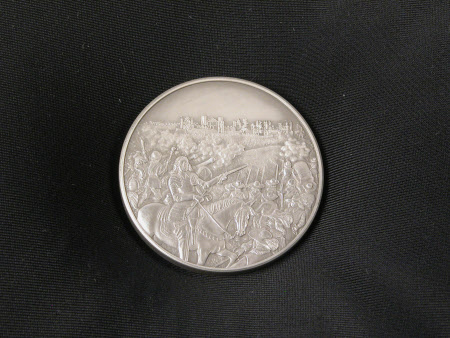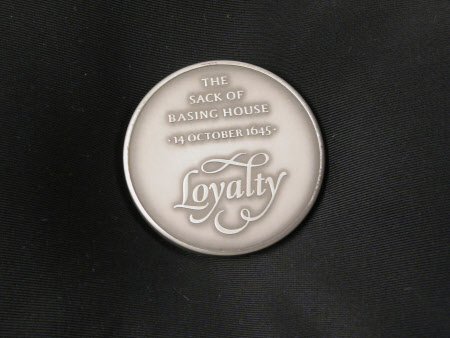The Sack of Basing House
Michael Rizzello (1926-2004)
Category
Coins and medals
Date
1993
Materials
Silver
Measurements
517 mm (Diameter)
Place of origin
United Kingdom
Order this imageCollection
Osterley Park and House, London
NT 773255
Summary
Silver, The Sack of Basing House, medal designed by Michael Rizzello (1926-2004) and Michael Harvey (1931-2013), struck Royal Mint, Llantrisant, 1993. A silver medal commemorating the Sack of Basing House on 14 October 1645. The eighth medal in a set of twelve issued by the Royal Mint in 1992 and 1993, to mark the 350th Anniversary of the English Civil War. The obverse, designed by Michael Rizzello, depicts Oliver Cromwell on horseback, directing the siege of Basing House, a royalist stronghold in Hampshire that had resisted three earlier sieges. Cromwell directs the heavy artillery that was in the fourth siege to succeed in breaking the defences of the house. The legend on the reverse, designed by Michael Harvey, reads: 'THE SACK OF BASING HOUSE. / 14 OCTOBER 1645. / Loyalty'. The word ‘Loyalty’ refers to the constant loyalty to the King of the owner of Basing House, the marquess of Winchester, and his fellow defenders.
Full description
The Civil War was fought, mainly in England, between 1642 and 1649, the result of a long struggle for power between King Charles I (1600-49) and Parliament. The medal depicts one of the final engagements in the Civil war, the successful besieging of Basing House by Parliamentary forces under Oliver Cromwell. A fine Tudor house, Basing House was strategically important as it commanded the road to the West country. It was the home of a leading Catholic, John Paulet, 5th Marquess of Winchester (c. 1598-1675), who early declared for the King and had Basing House garrisoned. It provided refuge for a number of distinguished royalists, among them the architect Inigo Jones and the printmaker Wenceslaus Hollar. The house was unsuccessfully besieged on three occasions in 1643 and 1644. Finally, after the victory at Naseby, Oliver Cromwell brought heavy artillery which quickly succeeded in breaching the fortifications, allowing the Parliamentarians to take the house with relative ease. As the defenders were generally regarded by their opponents as Papists, licence was given for much slaughter and looting. After the siege Cromwell had the fortifications and the house demolished. This was the eighth in a series of twelve medals issued by the Royal Mint at monthly intervals from June 1992, to celebrate the 350th anniversary of the outbreak of the English Civil War. The twelve medals illustrate the significant points in the conflict, from the raising of Charles I’s standard at Nottingham on 22 August 1642, to his execution on 30 January 1649. The designs of the obverses of the medals were commissioned from three leading contemporary artists, John Lobban, Michael Rizzello and Avril Vaughan, whilst the reverses, each of which contains a quotation relating to the subject of the medal, were designed by the distinguished lettering artist Michael Harvey, best-known for the names of celebrated Renaissance artists carved into the stonework of the Sainsbury Wing of the National Gallery. Michael Harvey’s original artwork for the series is in the Library of the University of Reading (URL MS 5115, file 392). The selection of the twelve episodes and the accompanying legend was devised by the historian of Tudor coinage Dr Christopher Challis. The medals were issued in silver and in bronze, in editions of 2,500 and 5,000, retailing at £84.50 or £49.50 per medal respectively. It was possible to buy the medals singly or as a set of twelve, the latter housed in an African walnut case. The whole series is in the collection at Osterley, but without the wooden case (NT 773248-773258, NT 773623). Jeremy Warren 2019
Provenance
Given to the National Trust in 1993 by George Child Villiers, 9th Earl of Jersey (1910-1998).
Marks and inscriptions
Reverse, legend: THE SACK OF BASING HOUSE. / 14 OCTOBER 1645. / Loyalty
Makers and roles
Michael Rizzello (1926-2004), designer Michael Harvey (1931-2013), designer The Royal Mint, manufacturer

